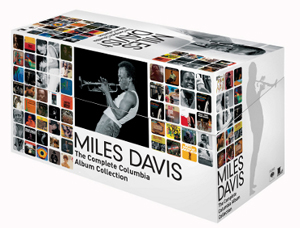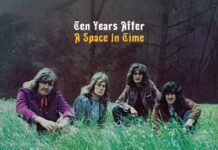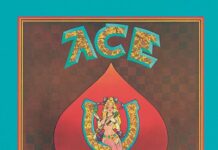What a way to cap off the 50th anniversary of one of the greatest years in jazz. Sony’s Legacy label rolled out the red carpet early in 2009 to celebrate Kind Of Blue, 1959’s seminal jazz album from the incomparable Miles Davis. Other great works of jazz fell from the sky in 1959 — namely Charles Mingus’ Mingus Ah Um, The Dave Brubeck Quartet’s Time Out and Ornette Coleman’s The Shape Of Jazz To Come — but it was definitely a banner year for Davis. So Legacy has pulled out all the stops and boxed the jazz legend’s entire Columbia catalog together — 52 albums over 70 CDs recorded from 1949 through 1985. The Complete Columbia Album Collection is the last answer to the question of who was one of the most important jazz musicians of the 20th century.
To appreciate Miles Davis, you have to grasp his zest for exploration, which contributed to an ongoing metamorphosis of the music. Over the course of his 50-year career, Davis pushed the envelope beyond the scope of traditional jazz. By the time, he’d recorded ‘Round About Midnight, his debut album on Columbia, Davis was already breaking the rules, indulging in new flavors of cool jazz, be bop and blues. Throughout the 50s, he was supported by some of the genre’s most gifted players — pianist Red Garland, bassist Paul Chambers, drummer Philly Joe Jones, drummer Jimmy Cobb, alto saxophonist Cannonball Adderly, pianist Bill Evans, and, of course, the incomparable tenor saxophonist John Coltrane. That was only the half of it.
Davis also teamed with composer and arranger Gil Evans for more complex pieces,
producing a magnificent adaptation of George Gershwin’s opera Porgy And Bess, and tapping into eclectic flamenco flavorings two years later on Sketches Of Spain. The pace only accelerated as more Miles Davis records on Columbia hit the racks — Someday My Prince Will Come (1961), In Person: Friday Night At The Blackhawk (1961), In Person: Saturday Night At The Blackhawk (1961), At Carnegie Hall (1962), Quiet Nights (1963), Seven Steps To Heaven (1963), In Europe (1964), Miles In Berlin (1965), My Funny Valentine (1965) and E.S.P. (1965),). During the first half of the 60s, Miles Davis was unquestionably the most popular jazz musician in the world. Even then, however, he wasn’t about to rest on his laurels.
The original quintet was history, so Davis recruited new and young talent to keep him on track. Drummer Tony Williams, pianist Herbie Hancock, bassist Ron Carter and tenor saxophonist Wayne Shorter — the second great quintet — not only pushed Davis into new, sometimes abstract areas; they also had a big hand in the writing. The combo released Miles Smiles (1967), Sorcerer (1967), Nefertiti (1968), Miles In The Sky (1968) and Filles De Kilimanjaro (1968).
A major shift away from the soulful, funky strains of the mid 60s gave way to a more sublime, contemporary direction in the late 60s, incorporating electric guitars, electric pianos and gigs with the Grateful Dead at the Fillmore. The revolving door for new blood swung wide open, welcoming the likes of Chick Corea, Joe Zawinul and John McLaughlin, all of whom would go on to form hugely influential groups of their own. Certainly, the albums they played on — In A Silent Way (1969), Bitches Brew (1970) and A Tribute To Jack Johnson (1971) — helped pave the way for what became known as “fusion,” loosely defined as a marriage of jazz and rock.
The music was simplified a bit and got funky on On The Corner (1972) and Get Up With It (1974), but health issues and drug problems sidelined Davis from making music from 1975 until 1980. The Man With The Horn (1981), his comeback album, didn’t exactly burn up the charts, but it showed signs of life. By this time, musicians such as drummer Vincent Wilburn, Jr., (Davis’ nephew), reedman Branford Marsalis, saxophonist Bill Evans, bassist Daryl Jones and guitarist John Scofield had entered the fray, helping to realize Star People (1983), Decoy (1983) and You’re Under Arrest (1985), the final records from Miles Davis recorded for Columbia.
Along with the studio records and chronological concert packages, the box set has a generous offering of miscellaneous live and studio collections, all released, with the exception of one disc, during Mile Davis’ lifetime. In Paris Festival International De Jazz May, 1949, Circle In The Round, At Plugged Nickel, Dark Magus, Agharta, Pangaea and We Want Miles are among the treasures of rarities and concert performances, some with bonus tracks. Davis’ celebrated appearance at the 1970 Isle Of Wight is also included, available in its entirety for the very first time.
In addition to the CDs, which are all packaged in mini LP jackets that replicate the original artwork, there are a few extras to make the box all the more tantalizing. A 250-page book with an extensive essay written by Frédéric Goaty, annotations on every album and DVD written by Franck Bergerot, photos, memorabilia, production notes, and whatnot, will fill you in on every moment in the studio and on stage.
The crown jewel of The Complete Columbia Album Collection may well be the DVD of the Miles Davis Quintet, Live In Europe. Davis, Wayne Shorter, Herbie Hancock, Ron Carter and Tony Williams swing through two separate European concerts, filmed in Stockholm, Sweden, and Karlsruhe, Germany, in 1967. This may only cover one phase of the man’s life, and perhaps a couple more DVDs from different periods would have provided a better balance. Even so, to see the man at the top of his game, no matter when it was, is to see an icon in the making.
~ Shawn Perry




















